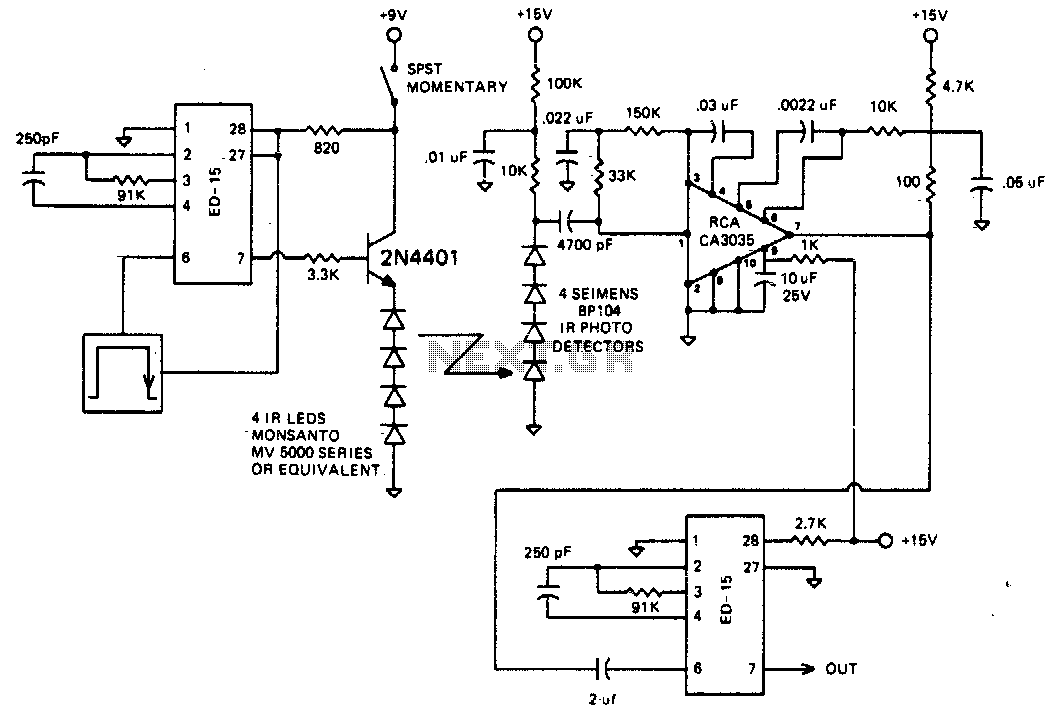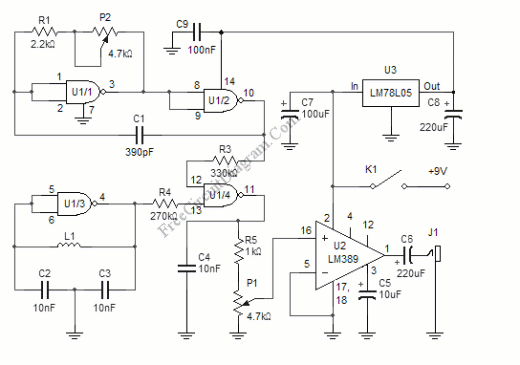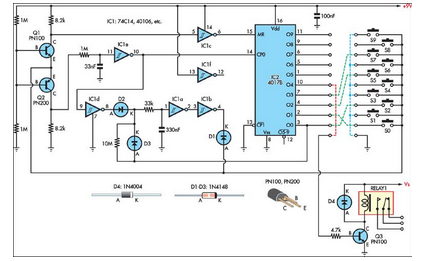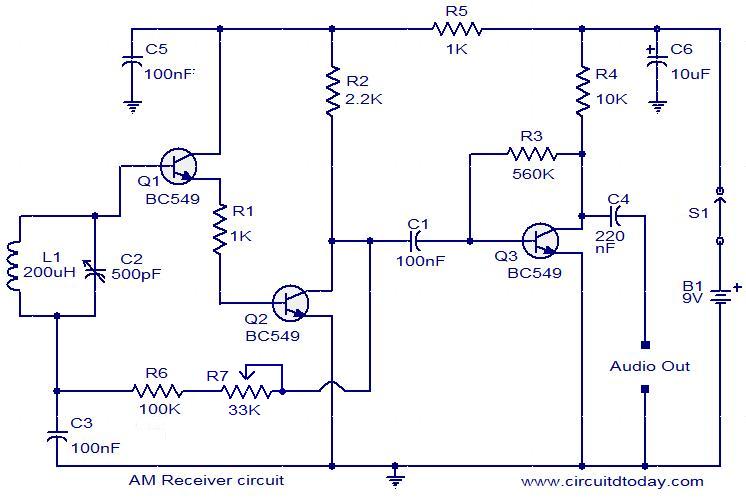
3.5 To 10Mhz Simple Superheterodyne Receiver

In this circuit, U1 is a frequency converter that supplies the 455-kHz intermediate frequency (IF) stage U2 and detector U3. U4 serves as the audio output stage. R9 functions as a gain control, allowing for the adjustment of the gain of U2. Coil data is provided in the parts list. R6 and R7 are 10k ohm resistors, while R9 is a 10k ohm potentiometer. T1 and T2 are 10.7 MHz microminiature (7mm) IF transformers, with Mouser part number 42IF223 for the green core and T3 and T4 are 455 kHz microminiature (7mm) IF transformers, with Mouser part number 42IF203 for the black core. U1 and U3 are NE602 double-balanced mixers, U2 is an MC3340 variable attenuator, U4 is an LM380N-8 audio amplifier, and U5 is a 78L05 100 mA miniature +5V regulator. Capacitors C10 and C11 can range from 0.1 to 0.22 µF, with values greater than 0.33 µF causing distortion. Additional components include printed stripboard (DSE PN H5614 or equivalent), a cabinet, plastic stick-on feet, and 4-40 hardware.
The circuit operates primarily as a radio frequency (RF) signal processing unit, converting incoming RF signals into audio output. The frequency converter U1 takes an RF input and down-converts it to a 455 kHz IF signal, which is then processed by U2, the variable attenuator. The gain control resistor R9 allows for fine-tuning the output level of the IF stage, ensuring optimal performance based on varying signal strengths.
The NE602 mixers (U1 and U3) are integral to the conversion process, providing high selectivity and low distortion, essential for maintaining signal integrity. The audio output stage, using the LM380N-8, amplifies the processed audio signal for output. The use of microminiature transformers (T1, T2, T3, and T4) minimizes space while allowing for efficient signal coupling between stages.
Capacitors C10 and C11 play a critical role in filtering and stabilizing the circuit. The specified range of capacitance values is crucial to prevent distortion, particularly in audio applications. A printed stripboard is utilized for assembly, providing a compact and efficient layout for the components, while the plastic stick-on feet and 4-40 hardware ensure a secure and stable installation.
Overall, this circuit is designed for effective signal processing in radio frequency applications, balancing size, performance, and ease of assembly. In this circuit, Ul is a frequency converter that feeds the 455-kHz IF stage U2 and detector U3. U4 is the audio output stage. R9 is a gain control that varies the gain of U2. Coil data is given in the part list. R6, R710k, YiWcarbon composition R910kpotentiometer T1, T210.7 MHzmicrominiature (7mm)Mouser PN 42IF223 IF transformer, green core T3,T4455 kHzmicrominiature (7mm)Mouser PN 42IF203 IF transformer, black core U1, U3NE602double-balanced mixer U2MC3340variable attenuator U4LM380N-8audio amplifier U578L05100 mA miniature+5V regulator * C10 and C11 can range from 0.1 to 0.22. Valves greater than 0.33 cause distortion. Other: Printed stripboard, DSE PN H5614 or equivalent, cabinet, plastic stick-on feet, 4-40 hardware, etc.
The circuit operates primarily as a radio frequency (RF) signal processing unit, converting incoming RF signals into audio output. The frequency converter U1 takes an RF input and down-converts it to a 455 kHz IF signal, which is then processed by U2, the variable attenuator. The gain control resistor R9 allows for fine-tuning the output level of the IF stage, ensuring optimal performance based on varying signal strengths.
The NE602 mixers (U1 and U3) are integral to the conversion process, providing high selectivity and low distortion, essential for maintaining signal integrity. The audio output stage, using the LM380N-8, amplifies the processed audio signal for output. The use of microminiature transformers (T1, T2, T3, and T4) minimizes space while allowing for efficient signal coupling between stages.
Capacitors C10 and C11 play a critical role in filtering and stabilizing the circuit. The specified range of capacitance values is crucial to prevent distortion, particularly in audio applications. A printed stripboard is utilized for assembly, providing a compact and efficient layout for the components, while the plastic stick-on feet and 4-40 hardware ensure a secure and stable installation.
Overall, this circuit is designed for effective signal processing in radio frequency applications, balancing size, performance, and ease of assembly. In this circuit, Ul is a frequency converter that feeds the 455-kHz IF stage U2 and detector U3. U4 is the audio output stage. R9 is a gain control that varies the gain of U2. Coil data is given in the part list. R6, R710k, YiWcarbon composition R910kpotentiometer T1, T210.7 MHzmicrominiature (7mm)Mouser PN 42IF223 IF transformer, green core T3,T4455 kHzmicrominiature (7mm)Mouser PN 42IF203 IF transformer, black core U1, U3NE602double-balanced mixer U2MC3340variable attenuator U4LM380N-8audio amplifier U578L05100 mA miniature+5V regulator * C10 and C11 can range from 0.1 to 0.22. Valves greater than 0.33 cause distortion. Other: Printed stripboard, DSE PN H5614 or equivalent, cabinet, plastic stick-on feet, 4-40 hardware, etc.





